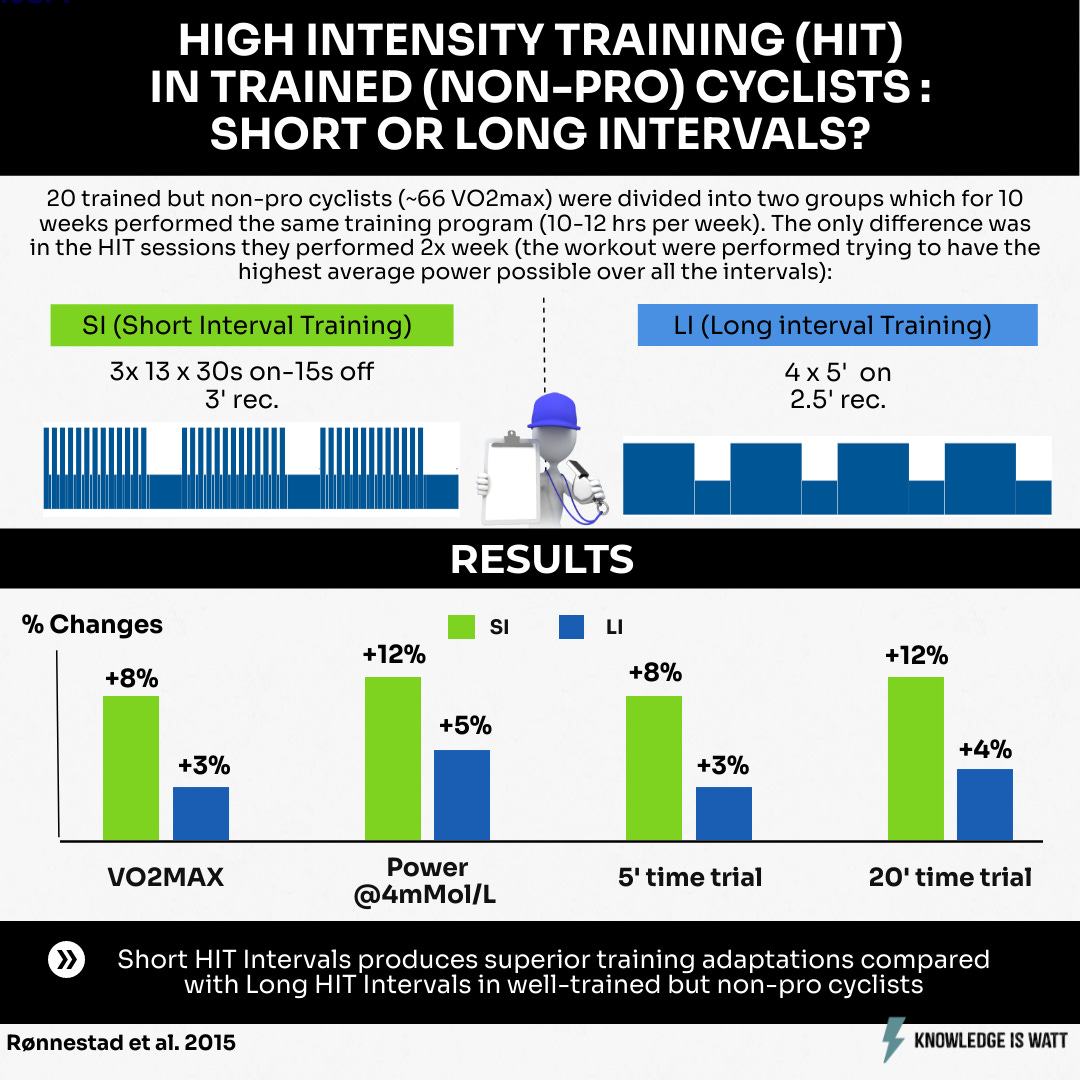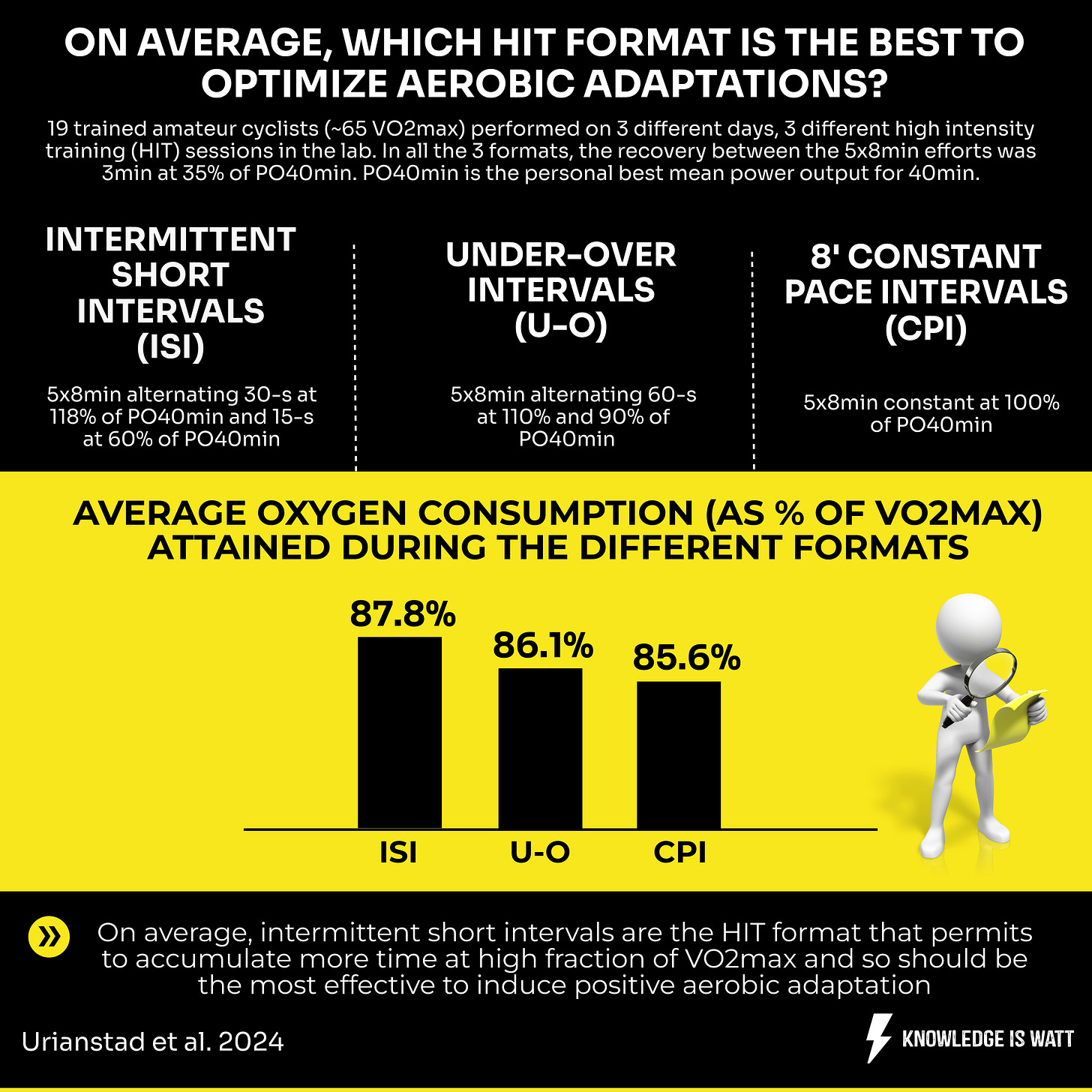
SCIENTIFIC BACKGROUND:
Short high intensity intermittent intervals are a HIT format in which the work duration is 15sec-1 min and the active-recovery ratio is 1:1 or higher (for example: 3:2 or 2:1).
In previous KIW Research Notes, we saw that short high intensity intermittent intervals promotes superior aerobic physiological and performance adaptations (VO2max, power at thresholds, 20min TT) when compared to long high intensity interval. This has been shown both in trained amateur (1) and professional (2) road cyclists.
Specifically, in both the two cited studies, the workouts compared were:
short high intensity intermittent intervals:
3x13’ alternating 30’’ ‘on’/15’’ ‘off’ with 3’ recovery at high zone 1 or low zone 2 (using a 5/7 zoned model).
long intervals:
4x5’ ‘on’ with 2.5’ recovery at high zone 1 or low zone 2 (using a 5/7 zoned model).
If you make some calculations, you can see as both short and long HIT workouts accumulated a similar time at high intensity (sum of the ‘on’ phases): 19min30s vs 20 min. In both HIT’s formats, the ‘on’ phases were performed at the maximum sustainable effort to obtain the highest average power throughout all the intervals. Interestingly, despite the similar rate of perceived exertion, the average power during the ‘on’ phases was higher in the short intermittent vs long intervals (~130% vs ~115% of second threshold). So, it seems like the capacity to work at a higher intensity despite a similar rate of perceived exertion and total time spent at a high intensity power is what make short intervals superior in promoting aerobic adaptations
This is line with a very recent couple of studies which showed that:
Working at a higher fraction of maximal oxygen consumption (VO2max) is the key factor to get the most from HIT sessions for what concern aerobic physiological and performance gains; (3)
The short high intensity intermittent intervals are the HIT format which permit to optimize time spent at high fraction of VO2max when compared to other HIT formats, such as steady long intervals and under-over intervals (alternating phases just above FTP to phases to just below FTP); (4)
So, the ‘superpower’ of short high intensity intermittent intervals seems to be the following:
while the specific number of series, intervals’ length and intensity of the ‘on’ phases, can vary between different prescribed workouts, when matching rate of perceived exertion and total time spent at high intensity power output, they permit to accumulate more time at higher fraction of VO2max and so they stimulate more aerobic physiological and performance gains when compared to other HIT formats!
The high intensity intermittent short intervals’ workout used by the above cited studies (3x13’ alternating 30’’ ‘on’/15’’ ‘off’ with 3’ recovery) could give a strong performance boost in the short term. However, when starting to put this HIT format in a training plan, I suggest to do not copy and past it: it is quite hard! I would rather start with a lighter version using less repetitions, less series and/or a lower on-off ratio, and then applying a progressive overload through the weeks manipulating (increasing) these variables:
Number of series
Number of repetitions
On-off work ratio.
This can be important to avoid a ‘from 0 to 100’ strategy (from no short intermittent high intensity intervals to its ‘hardest’ version) and to maintain space to increase the load within this HIT format through the weeks, which might be crucial to maintain responsiveness to this stimulus and to avoid stagnation in performance gains.
Here below I would show you a practical example on how to do it.
A PRACTICAL EXAMPLE ON HOW TO APPLY THE SHORT HIGH INTENSITY INTERMITTENT INTERVALS WITH PROGRESSIVE OVERLOAD:
Keep reading with a 7-day free trial
Subscribe to Knowledgeiswatt English to keep reading this post and get 7 days of free access to the full post archives.




